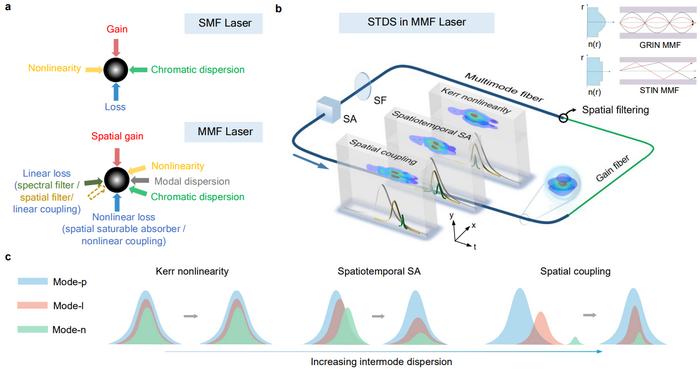Spatiotemporal mode-locking (STML) has been a hot topic since 2017 (Science 358, 94–97 (2017)). However, comprehension and control of spatiotemporal dissipative solitons (STDSs) and STML in multi-mode fiber (MMF) lasers are not as mature as those in single-mode fiber lasers. Some of the key challenges include achieving ultrahigh pulse energy and arbitrary mode profiles in MMF lasers and refining spatiotemporal characterization techniques. Tackling these challenges would unlock diverse applications for MMF lasers.

Credit: by Bo Cao, Chenxin Gao, Kewei Liu, Xiaosheng Xiao, Changxi Yang, and Chengying Bao
Spatiotemporal mode-locking (STML) has been a hot topic since 2017 (Science 358, 94–97 (2017)). However, comprehension and control of spatiotemporal dissipative solitons (STDSs) and STML in multi-mode fiber (MMF) lasers are not as mature as those in single-mode fiber lasers. Some of the key challenges include achieving ultrahigh pulse energy and arbitrary mode profiles in MMF lasers and refining spatiotemporal characterization techniques. Tackling these challenges would unlock diverse applications for MMF lasers.
Recently, a review article entitled “Spatiotemporal mode-locking and dissipative solitons in multimode fiber lasers” was published in Light: Science & Applications by the team led by Changxi Yang and Chengying Bao from Tsinghua University, China. This review summarizes the research progress on STML and STDS in MMF lasers and outlines several perspectives that may bring breakthroughs for STML lasers.
Balancing intermode dispersion and synchronizing mode-resolved pulses are a prerequisite for STML. Three dominant mechanisms contributing to balancing intermode dispersion and govern STML are depicted in Fig. 1.
Real-time, multi-dimensional optical field measurements are crucial to grasp spatiotemporal dynamics. Combining techniques like multimode dispersion Fourier transform, time lenses, mode decomposition, and timing jitter measurements may make a powerful system to characterize spatiotemporal dynamics of STDSs.
Customizing mode components in multimode lasers remains challenging. Beam self-cleaning, or introducing spatial light modulators may enable mode field control of STML lasers. Attaining high pulse energy with user-defined mode profile can open the door for many exciting applications including nonlinear microscopy. Moreover, spatial coherence may add new possibilities for applications (e.g., chaotic Lidar) where low coherence can be an advantage.
Finally, several applications and novel technological pathways of spatiotemporal mode-locked lasers are discussed (Fig. 2). Topics include multimode optical frequency combs, wavelength-division multiplexing for multimode lasers, generation of multimode supercontinuum, mode-locked single-cavity dual/multi-combs, and coherently-pumped multimode lasers. These advances may push our ability to control photons in loosely confined, multi-mode, nonlinear, ultrafast systems to a new level.
Journal
Light Science & Applications
DOI
10.1038/s41377-023-01305-0




